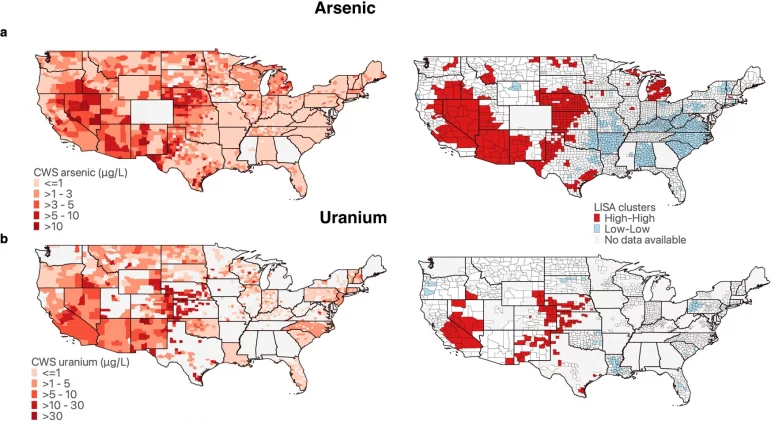TWH – Water is a revered substance in many faiths. Witchcraft and Paganism have a deep respect for water as one of the spiritual elements. Hinduism refers to water as one of the five great elements. Water, of course, is essential for life.
The availability of fresh, healthy water is also under assault. Five years after the Flint, Michigan water crisis, the crisis is not over. A recent study in the Journal of the American Medical Association found depression and Post Traumatic Stress Disorder are among the lingering effects of that crisis. They found “high rates of presumptive depression, PTSD, and comorbid mental disorder were found among adults living in the Flint community, although it is important to note that many adults were resilient.”
Another study looking at water contamination has highlighted how communities of color typically bear the brunt of contaminated water sources. Researchers from the Mailman School of Public Health at Columbia University have found that public drinking water in Black, Indigenous, and Latino communities have a higher concentration of arsenic and uranium when compared to other locations. The researchers reported their findings in Nature Communications earlier this month and underscored how the findings expose deficiencies in environmental justice.

Image by Jan Blanke from Pixabay
The U.S. Environmental Protection Agency (EPA) has regulations about the presence of both arsenic and uranium in U.S. public drinking water systems, including what is termed “community water systems (CWSs) which serve over 90% of residents year-round.” The agency noted in a 2015 report that arsenic exposure above 0.010 milligrams per liter of water can lead to “Skin damage or problems with circulatory systems and may have increased risk of getting cancer.”
The EPA noted in the same report that uranium over 30 micrograms per liter can lead to an “Increased risk of cancer, kidney toxicity.” These were identified as the maximum contaminant levels or “the level of a contaminant in drinking water below which there is no known or expected risk to health.”
The same report from the EPA also noted that arsenic sources include “Erosion of natural deposits; runoff from orchards, runoff from glass and electronics production wastes.” The uranium sources were noted only as “erosion of natural deposits.”
For the study, the researchers looked at county-level racial/ethnic composition defined as “the proportion of residents belonging to a given racial/ethnic group” and the CWS arsenic and uranium concentrations using geospatial models.
The researchers found that noted that arsenic and uranium levels in CWS drinking water were higher for Indigenous and Latino communities across the United States. The researchers also found higher levels of those toxins in Black communities in the U.S. West and Midwest.
The researchers noted that their findings are consistent with previous research on the topic. They “anticipated that the association between racial/ethnic composition and CWS arsenic and uranium concentrations would be unique for each racial/ethnic group and would differ in magnitude and direction of the association across different regions of the U.S. because of regional differences in racial/ethnic composition, geologic context, urban vs rural landscapes, and land-use patterns relevant for drinking water arsenic and uranium concentrations.”
The current research went further. The findings show that “higher proportions of Hispanic/Latino and American Indian/Alaskan Native residents are associated with significantly higher CWS arsenic and uranium concentrations at the county-level, while higher proportions of non-Hispanic White residents are associated with lower CWS arsenic and uranium concentrations.”
The researchers noted that “structural racism likely underlies these inequalities in drinking water quality.” They noted not only connections with Black, Indigenous, and Latino communities but also water systems serving incarcerated populations.

Nationwide spatial distribution of county-level community water system (CWS) metal concentrations and local indicators of spatial associations (LISA) clusters. – via Nature Communicatiions
Still, it is never a single cause that determines drinking water quality or contamination. Dr. Anne Nigra, assistant professor of Environmental Health Sciences at Columbia University and one of the authors of the study told Inside Climate News, “It’s not typically one mechanism that’s at fault, but it’s multiple ways in which structural racism is acting upon water, utilities and regulators that result in these types of inequities.” Nigra added, “It’s rarely one person making a racist decision.”
Nigra and her colleagues noted that there are natural sources of water contaminants. The researchers noted that their “findings suggest that racial/ethnic inequalities in public water contaminant exposures may be more likely or more severe in geographic regions with both a high percentage of public water users of the specified racial/ethnic group and relatively high concentrations of specific contaminants in source water.” However, when areas with natural geological sources of arsenic and uranium overlap with communities of color, that is where the greatest levels of contamination and inequality co-occur.
The researchers at Columbia noted, “Racial/ethnic inequalities in public drinking water arsenic and uranium concentrations are unacceptable.” Future research – they hope – can identify and explore the inequalities to provide for healthy fresh water as well as environmental justice.
The Wild Hunt is not responsible for links to external content.
To join a conversation on this post:
Visit our The Wild Hunt subreddit! Point your favorite browser to https://www.reddit.com/r/The_Wild_Hunt_News/, then click “JOIN”. Make sure to click the bell, too, to be notified of new articles posted to our subreddit.